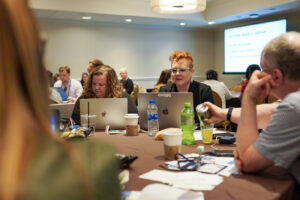Technology is embedded in almost every aspect of our lives – from travel, finances, cooking, fitness, and learning. Many educators would also likely note that just because technology is available and used doesn’t necessarily mean it is an effective or intentional part of learning experiences. Without a roadmap for integrating and using technology, making informed decisions and measuring its effectiveness can be challenging. For innovations in teaching and learning to be most productive, they often benefit from frameworks that help guide exploration and innovation activities.
One practice that has seen a remarkably important advancement over the last decade is blended learning. As technology tools and infrastructure have matured, using digital and in-person spaces to support learning and teaching has grown. Blended learning is not just combining in-person and online teaching. Blended learning is an intentional and strategic approach to using multiple learning spaces and places that are focused on achieving a defined learning purpose and goals. In a well-developed blended learning strategy, each learning space is designed to support an optimal feature or need of a learning experience. You might think of blended learning as the Gestalt principle applied to learning environments where the whole is greater than the sum of its parts.
One important feature for innovation in teaching and learning is having frameworks to guide and talk about data and implications. The work related to blended teaching in K12 environments has already started; however, blended teaching in higher education often relies on a collection of related yet separate knowledge domains. This creates a type of cottage industry for blended teaching in higher education where educators are mostly on their own to recognize and see the connections in the outcomes, practices, policies, ecosystem, and enabling technologies.
This article offers a starting point for identifying and organizing blended teaching competencies in higher education which will be further developed during the OLC Blended Learning Symposium 2023.
Teaching competencies: the foundation of innovation in blended teaching
What makes an excellent teacher? This is the question at the heart of work in competency modeling for blended teaching. Without a foundational framework for understanding what it means to be excellent at something, supporting and investing in experiences that help develop capabilities aligned to a reliable framework and appropriate ways to recognize excellence based on this foundation is difficult.
Competencies, also sometimes called capabilities, describe the knowledge, skills, abilities, and attitudes it takes to do a job or be part of a professional guild or community of practice. Competencies are often organized in competency models to represent the inclusion and connection of competencies as part of a larger framework. The competency/capability models for Association for Talent Development and the Society for Human Resource Management are widely used examples of professional competencies models.
Competencies for blended teaching have been developed for the K-12 environment; however, higher education blended teaching remains important work in front of us. Among other essential questions, examining if the blended teaching competencies for K-12 environments of 1) online integration, 2) data practices, 3) personalization, and 4) online interaction remain essential to higher education environments or if additional competencies or contextualization may be needed. This takes integrating data and design to examine and propose an initial model for blended teaching in higher education.
Why the need for blended teaching competencies in higher education?
The practical reality of teaching in higher education environments is that the vast majority of educators are already operating in learning environments that combine multiple spaces such as in-person and digital. What separates, and often limits, teaching practices is the intentionality of planning, design, and facilitation that integrates multiple spaces around a unified learning purpose.
If we think of blended teaching as a designed network of nodes (learning spaces) and connections (how those spaces connect), a considerable about of effort is placed on the nodes, but less attention is given to the connections (how they all relate in a unified way). For the most part, educators rely on a combination of highly specific literature about teaching practices and professional experiences to guide decisions about designing and facilitating blended learning experiences.
A competency model specialized for blended teaching in higher education environments would provide a much-needed framework for research and practice and a guide for professional development and institutional innovation.
Uses for Blended Teaching Competencies
How would a competency model focused on blended teaching add value to higher education? A competency model focused on blended teaching in higher education establishes a foundation for future innovation and collaboration. At the most basic level, a competency model offers a common framework and language for collaboration in research, teaching, and innovation. Additional opportunities for leveraging a blended teaching competency model include:
- Establishing institutional policies and practices
- Describing what quality is in blended teaching and learning
- Guiding investments and efforts in professional development and technology
- Measuring and assessing teaching and learning outcomes
- Framing and connecting research and practice
- Recognizing and rewarding excellence in blended teaching
A blended teaching competency model is a foundational step in the professionalization of this important practice in higher education. To achieve this aim, deep collaboration, engagement, and contributions will be needed across higher education. To help support this initial work, we will facilitate a collaborative design workshop at the OLC Blended Learning Symposium 2023.
This unique, interactive workshop involves participants in co-creating a competency framework for blended teaching in higher education. Building on Charles Graham’s work in K-12 education settings, the goal of this workshop is to collaboratively create a competency model prototype for guiding leadership and faculty development for blended learning in higher education. We will use design thinking methods for supporting ideation, concept development, and collaboration. This workshop is a learning-through-doing experience, meaning you will be an active co-creator and contributor to the workshop outcomes.
The workshop will use the following principles for guiding collaboration:
- Through facilitated collaboration processes, create a prototype competency model for blended teaching in higher education
- Develop foundational and specialized competencies for blended teaching in higher education
- Create user stories that illustrate the application of each competency in practice
- Anticipate how change, innovation, and disruption may influence the competency model over time
- Identify practical opportunities for using the competency model to advance blended teaching in higher education
Each workshop participant will have access to the portfolio of collaboration artifacts developed during the workshop.
Resources:




